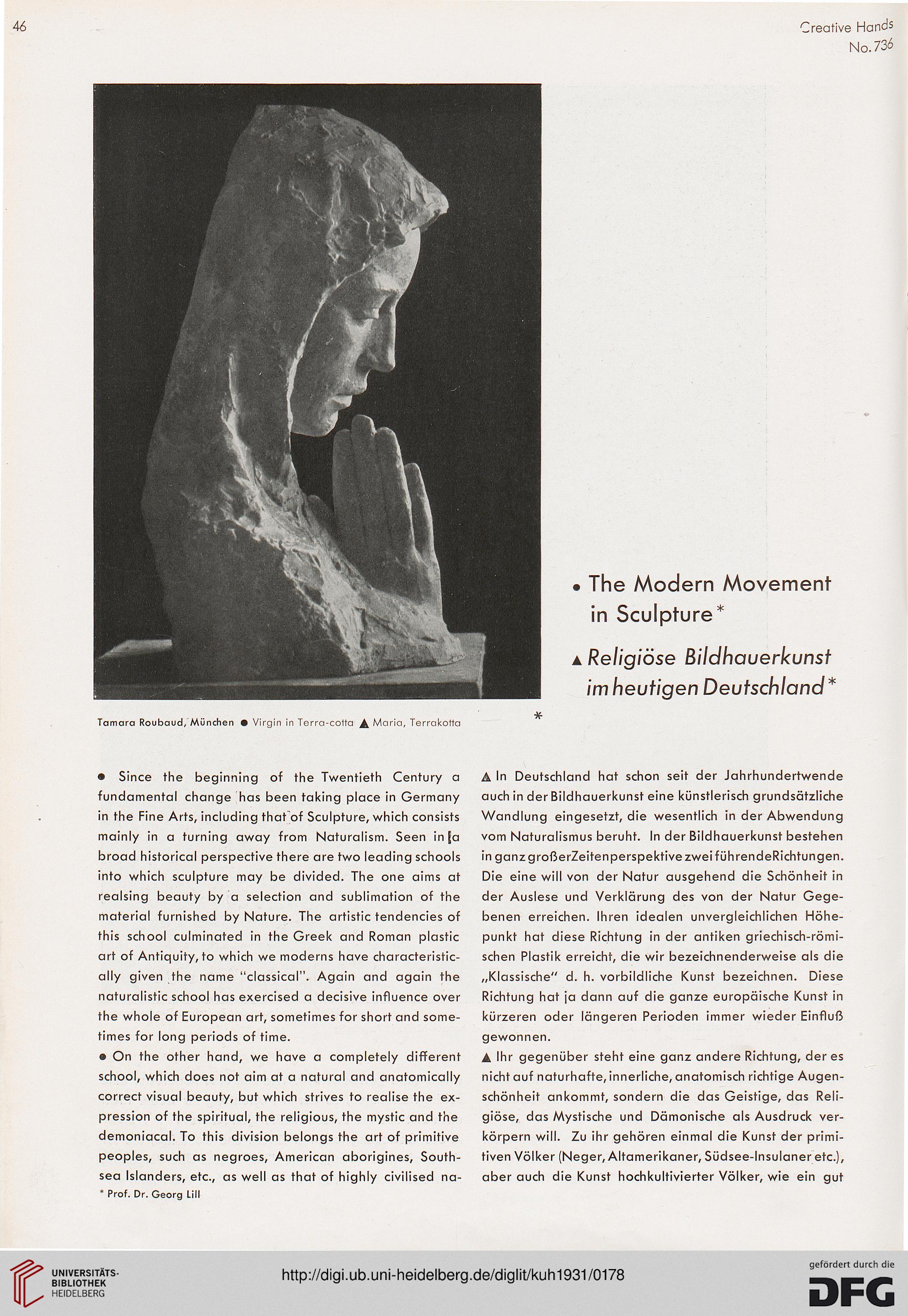Creative
Hands
No.736
• The Modern Movement
in Sculpture*
▲ Religiöse Bildhauerkunst
im heutigen Deutschland *
Tamara Roubaud, München • Virgin in Terra-cotta A Maria, Terrakotta
• Since the beginning of the Twentieth Century a
fundamental change has been taking place in Germany
in the Fine Arts, including that of Sculpture, which consists
mainly in a turning away from Naturalism. Seen in [a
broad historical perspective there are two leading schools
into which sculpture may be divided. The one aims at
realsing beauty by a selection and Sublimation of the
material furnished by Nature. The artistic tendencies of
this school culminated in the Greek and Roman plastic
art of Antiquity, to which we moderns have characteristic-
ally given the name "classical". Again and again the
naturalistic school has exercised a decisive influence over
the whole of European art, sometimes for short and some-
times for long periods of time.
• On the other hand, we have a completely different
school, which does not aim at a natural and anatomically
correct visual beauty, but which strives to realise the ex-
pression of the spiritual, the religious, the mystic and the
demoniacal. To this division belongs the art of primitive
peoples, such as negroes, American aborigines, South-
sea Islanders, etc., as well as that of highly civilised na-
• Prof. Dr. Georg Lill
A In Deutschland hat schon seit der Jahrhundertwende
auch in der Bildhauerkunst eine künstlerisch grundsätzliche
Wandlung eingesetzt, die wesentlich in der Abwendung
vom Naturalismus beruht. In der Bildhauerkunst bestehen
in ganz großerZeiten Perspektive zwei führen deRichtungen.
Die eine will von der Natur ausgehend die Schönheit in
der Auslese und Verklärung des von der Natur Gege-
benen erreichen. Ihren idealen unvergleichlichen Höhe-
punkt hat diese Richtung in der antiken griechisch-römi-
schen Plastik erreicht, die wir bezeichnenderweise als die
„Klassische" d. h. vorbildliche Kunst bezeichnen. Diese
Richtung hat ja dann auf die ganze europäische Kunst in
kürzeren oder längeren Perioden immer wieder Einfluß
gewonnen.
▲ Ihr gegenüber steht eine ganz andere Richtung, der es
nicht auf naturhafte, innerliche, anatomisch richtige Augen-
schönheit ankommt, sondern die das Geistige, das Reli-
giöse, das Mystische und Dämonische als Ausdruck ver-
körpern will. Zu ihr gehören einmal die Kunst der primi-
tiven Völker (Neger, Altamerikaner, Südsee-Insulaner etc.),
aber auch die Kunst hochkultivierter Völker, wie ein gut
Hands
No.736
• The Modern Movement
in Sculpture*
▲ Religiöse Bildhauerkunst
im heutigen Deutschland *
Tamara Roubaud, München • Virgin in Terra-cotta A Maria, Terrakotta
• Since the beginning of the Twentieth Century a
fundamental change has been taking place in Germany
in the Fine Arts, including that of Sculpture, which consists
mainly in a turning away from Naturalism. Seen in [a
broad historical perspective there are two leading schools
into which sculpture may be divided. The one aims at
realsing beauty by a selection and Sublimation of the
material furnished by Nature. The artistic tendencies of
this school culminated in the Greek and Roman plastic
art of Antiquity, to which we moderns have characteristic-
ally given the name "classical". Again and again the
naturalistic school has exercised a decisive influence over
the whole of European art, sometimes for short and some-
times for long periods of time.
• On the other hand, we have a completely different
school, which does not aim at a natural and anatomically
correct visual beauty, but which strives to realise the ex-
pression of the spiritual, the religious, the mystic and the
demoniacal. To this division belongs the art of primitive
peoples, such as negroes, American aborigines, South-
sea Islanders, etc., as well as that of highly civilised na-
• Prof. Dr. Georg Lill
A In Deutschland hat schon seit der Jahrhundertwende
auch in der Bildhauerkunst eine künstlerisch grundsätzliche
Wandlung eingesetzt, die wesentlich in der Abwendung
vom Naturalismus beruht. In der Bildhauerkunst bestehen
in ganz großerZeiten Perspektive zwei führen deRichtungen.
Die eine will von der Natur ausgehend die Schönheit in
der Auslese und Verklärung des von der Natur Gege-
benen erreichen. Ihren idealen unvergleichlichen Höhe-
punkt hat diese Richtung in der antiken griechisch-römi-
schen Plastik erreicht, die wir bezeichnenderweise als die
„Klassische" d. h. vorbildliche Kunst bezeichnen. Diese
Richtung hat ja dann auf die ganze europäische Kunst in
kürzeren oder längeren Perioden immer wieder Einfluß
gewonnen.
▲ Ihr gegenüber steht eine ganz andere Richtung, der es
nicht auf naturhafte, innerliche, anatomisch richtige Augen-
schönheit ankommt, sondern die das Geistige, das Reli-
giöse, das Mystische und Dämonische als Ausdruck ver-
körpern will. Zu ihr gehören einmal die Kunst der primi-
tiven Völker (Neger, Altamerikaner, Südsee-Insulaner etc.),
aber auch die Kunst hochkultivierter Völker, wie ein gut





